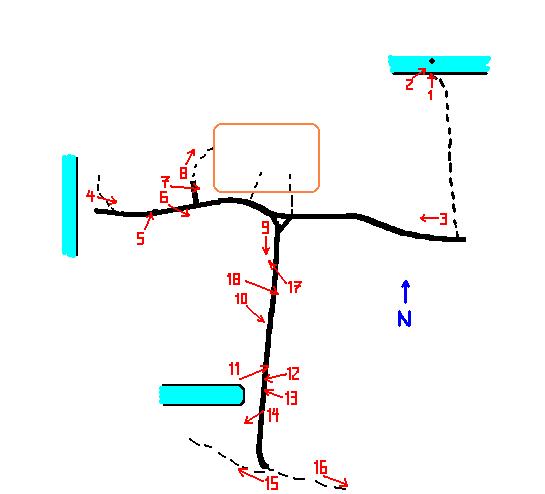Bünnewitz - Buniewice
Bünnewitz was the village I was
most anxious to see, since my earliest known LUCK ancestors showed up
there at the end of the 17th century. I knew most of the oldest
buildings had already been destroyed when the village was still German,
so I wasn't expecting to see much. What was important was walking
the same ground they walked, and I certainly got to do that.
The main road comes in from the east, and
at the edge of town changes from asphalt to hexagonal concrete cobbles.
Right at that point I was surprised to find a small prison. Since
I'm a retired Corrections Officer I went in, introduced myself and "flashed
tin". I got to take a tour and hang out with the boys for a while.
Very informative. For one thing, I think I found out why some
people responded a little strangely when I first took off my hat and introduced
myself. In this jail the first thing they do with an inmate is shave
his head, and I wear the same haircut. The jail itself is an extremely
grim little place, with none of the amenities, for both staff or inmates,
we've come to expect in American corrections. They told me pictures
were forbidden, and the one I took from the road didn't come out, so I've
got nothing to show here.
Between the jail and the town itself a dirt
road leads off to the right labeled "Glaz". This led to the "royal
stone", which has become one of the symbols for Kamien (Pictures
1 and 2
).
The northern part of town is taken up by
an "Agregat" company (the brown rectangle on the map below). They
seem to have fallen on hard times. Most of the buildings are empty,
there were two tractors and two old trucks in the yard, but the office was
closed and there wasn't much evidence of traffic.
On the main east-west road I met a man called
"Radach" who had the proverbial "cousin in Chicago" and spoke a little
English and German. I went with him to the Sklep (Picture
18), where there were four elderly women hanging
out. With Radach's help I was able to ask quite a few questions.
According to them: the concrete road cobbles were pre-war (and they're
in amazing shape); the old school house had been converted to a private
home two years ago; the present school is in the old 'Große Haus',
the apartment building built for the old cement factory workers (my picture
of that did not come out); the only working farm still left is the one south
of the Kanal (Pictures 14
and 15); although
there's only the one farm, livestock sales are still held a few times a
year at the stock ring across the street from the Sklep in the village
pasture (another picture that didn't come out); the biggest employer in
town is the jail; and there aren't any boats in the village anymore. Of
course, I don't know how much of that is true, or even if I correctly understood
everything they were telling me.

Click on any image to see it full size
 Return to Table of Contents
Return to Table of Contents

